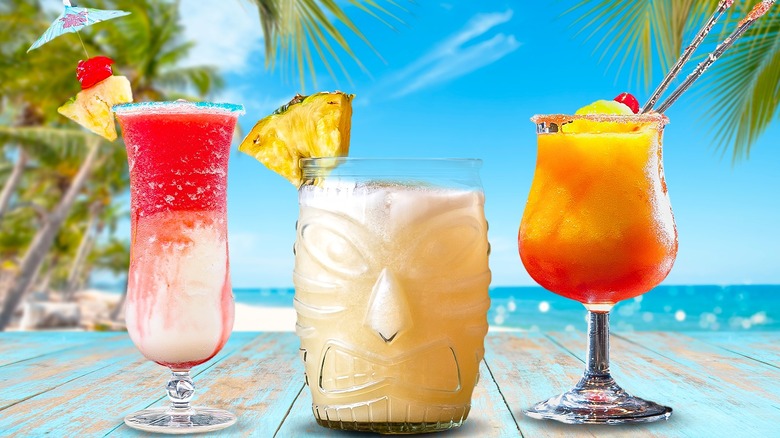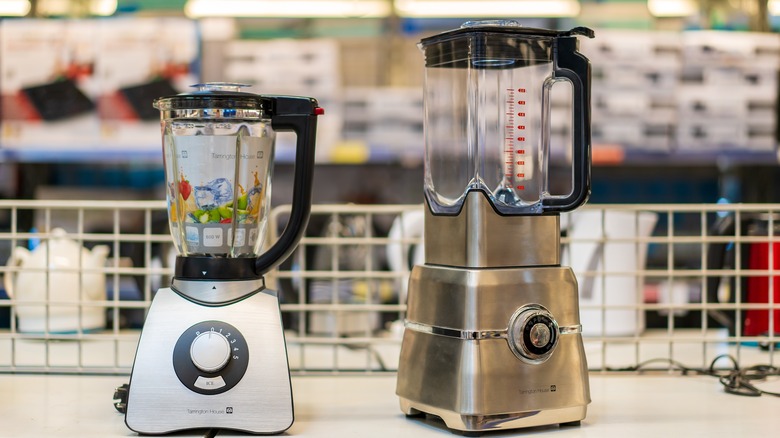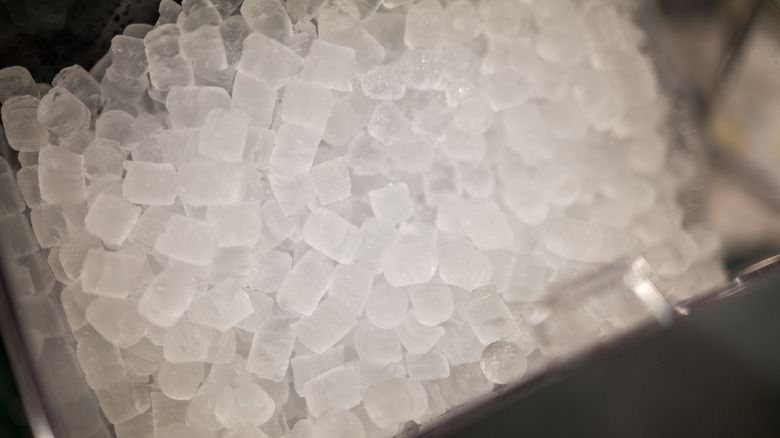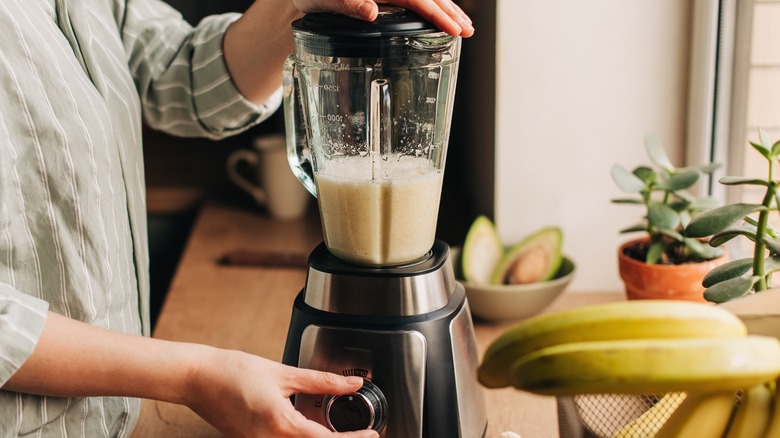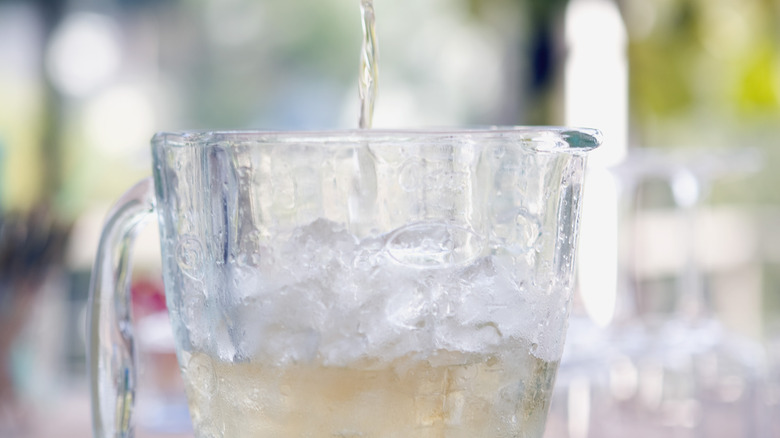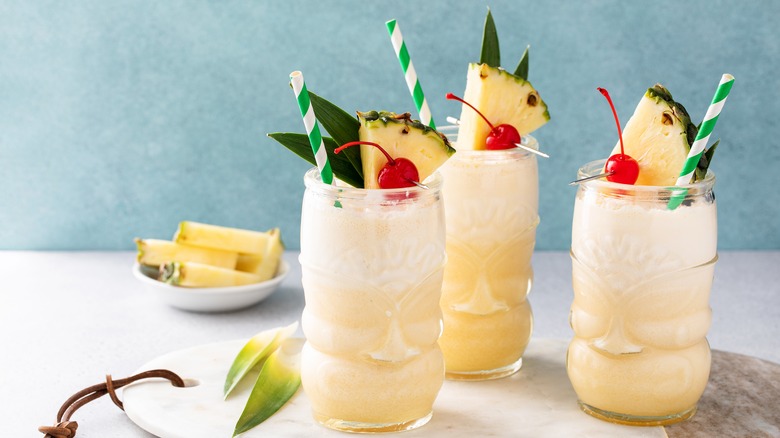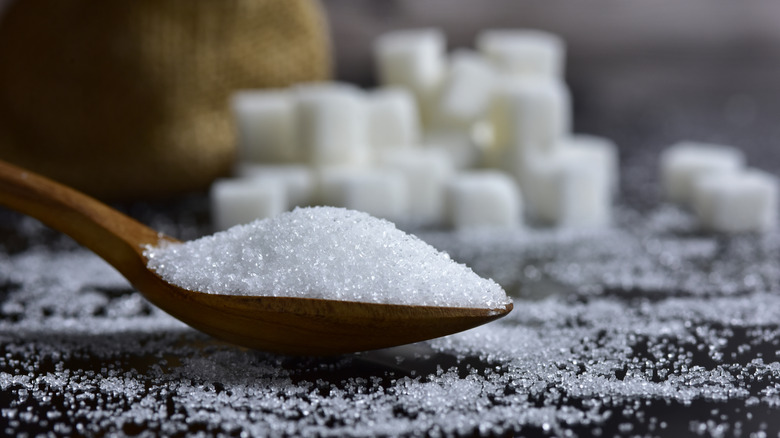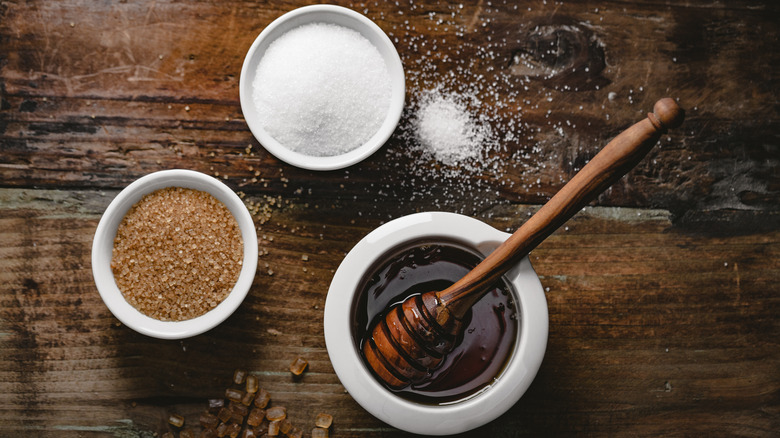8 Things You Need To Know For Blending Frozen Tiki Drinks
We may receive a commission on purchases made from links.
Nothing beats sitting on the beach or by the pool while sipping on a tiki cocktail, especially when it's served up in one of those cool tiki mugs. However, if you're not in the mood to be waited on, but still want to enjoy a frosty tropical elixir, you can easily whip one up at home. You just need the right ingredients and know what you're in the mood for.
When it comes to tiki cocktails to try, there are so many options — a mai tai, a zombie, even the classic hurricane. All of these provide great ways to cool off on a hot day, but sometimes the only drink that will quench one's palate is a slushy frozen cocktail. If you've ever tried to make this kind of blended drink at home, you know there's more to it than just adding ingredients and ice. Too much ice and you lose the flavor of the drink; not enough and you end up having a very strong (albeit chilled) cocktail.
Since everyone wants to achieve the perfect flavor and consistency in every frozen cocktail, we reached out to a few tiki-drink specialists for advice. These bartenders know a thing or two about mixing frozen drinks, and we asked them to share key steps for making ideally icy tiki cocktails. Read on to see what they suggest.
Fresh ice makes for better cocktails
How many times have you filled your ice trays and then forgotten all about them, only to reach for a cube a few weeks (or months) later when the urge to mix up a cool drink took hold, and discovered that the cubes have absorbed odors in the freezer? Don't be embarrassed; this is but one of the biggest ice cube mistakes we've all made. But here's the thing: that old ice is not ideal if you want to make a delicious cocktail.
Fresh ice is the only way to go when making a frozen cocktail, according to Cristian Diaz, a longtime bartender at California tiki bars who shares culinary hacks on the Adventures With Alchemy YouTube channel. "Clean ice leads to better drinks," Diaz declares, as leaving cubes "sitting in trays forever in your freezer can make the ice taste nasty." Yes, believe it or not, ice develops flavors from foods that it shares fridge space with over time. According to Diaz, that tainted ice "will directly affect the flavor of the drink," and if there's one thing nobody wants, it's a nasty-tasting cocktail. So, when gathering your frozen-drink ingredients, plan ahead so that those cubes are nice and fresh.
Make sure you have a quality blender
"Like quality tools in your garage," explains Cristian Diaz, making proper cocktails "requires quality equipment." The bartender isn't just talking about those large built-in appliances that line your kitchen walls. Drink-making equipment also includes the devices on your countertop — such as your blender. Using the best blender will allow you to turn multiple ingredients into a silky sauce or soup, but also grind up ice without breaking down.
Some blenders can do all that and more, while others are best suited for just one or two uses. So, before you rush out and buy the most expensive or popular blender, consider how you're going to use it. If it's primarily designated for mixing drinks, Diaz has a couple suggestions: "Forget that Ninja, and invest in a good-quality blender like Hamilton Beach or Vitamix."
Use smaller ice chunks
Indeed, the trick to better blended drinks is in the ice — but the age of your cubes isn't the only important factor when mixing up frozen cocktails. Matthew Tetrault, the lead bartender at Wusong Road tiki bar in Massachusetts, says the size of your cubes is important as well.
"Using crushed ice or crushing cubed ice into smaller chunks using a Lewis bag will keep your blender from working too hard, and heating up your cocktail," Tetrault explains — and no one wants a hot cocktail (at least not on a hot day). Not only will your tipple stay nice and cool, but by using smaller ice pellets you'll ideally get the appropriate dilution necessary to make the drink taste even better. But Tetrault gives a word of caution when using crushed ice: "Always be sure to measure the ice you use by weight instead of volume for accuracy." Tetrault suggests starting with roughly 160 grams of ice for each cocktail, and then adjusting for taste.
Blend your drinks thoroughly
When it comes to blending a cocktail, take the time to do it right. Cristian Diaz says that when making frozen drinks, patience is a virtue. "Most people want their drink right now, and don't blend the drink enough," explains Diaz.
Robert Adamson of Strong Water Anaheim agrees that "the right blend time is crucial," but cautions that blending for too long is equally problematic, noting that "over-blending leads to excessive dilution, while under-blending leaves ice chips behind." Those ice chips will ruin the drinking experience, because finding a jagged chunk of ice in your mouth instead of slushy sip can be a jarring experience.
So, Adamson suggests that the best way to avoid those ice chips is to time your blend. The bartenders at Strong Water Anaheim use a Hamilton Beach spindle blender, allowing the team to "flash-blend our drinks for exactly six seconds," which Adamson says is just enough time to achieve the perfect cocktail. However, another type of blender could require a different amount of time to achieve the right texture. If you don't want to pull out a stopwatch while mixing up drinks, Diaz recommends using your eyes and ears: "Blend the drink until it's smooth, doesn't make crunching noises, and has a whirlpool in the middle," adding that this shouldn't take much more than 15 seconds.
Carefully consider your ice-to-liquid ratio
Blending time isn't the only aspect of cocktail-making that Robert Adamson and Cristian Diaz agree on. They also say that your liquid-to-ice ratio is important. In fact, it may be equally important as the ingredients that make up your drink. You don't want to just start shoveling ice into your blender. Instead, both bartenders suggest that you go easy on the ice. "Too much ice waters down your drink, while too little can prevent proper blending," explains Adamson.
Diaz takes that recommendation a step further: "There should be enough ice that the liquid only covers about 70% of the ice inside the blender." So, in order to get the right proportions, Adamson recommends measuring out your ice just like how you measure out your liquor. At Strong Water Anaheim they use 6 ounces of pebble ice per drink. However, if you don't have a scale or simply prefer to eyeball your ingredients, Diaz has an easier suggestion. He says that your drink should end up with the same consistency as the smoothies from Jamba Juice.
Ingredients can make or break a frozen cocktail
Whenever we mix up a frozen cocktail, the first things we grab are spirits, various mixers, and ice. But those aren't the only ingredients you should be using. While these items are extremely important, if you only use liquid and ice, Cristian Diaz says you'll end up with a slushy drink that will melt faster than you can enjoy it. So, to make your tiki drink stay frozen longer, the bartender suggests adding other ingredients as well.
Fruit is always a popular choice, especially in tiki drinks, but we've seen varied additions blended into frozen cocktails. Each ingredient will enhance the final cocktail, making for something the imbiber wants to sip rather than chug. Diaz suggests "using fresh fruit, ice cream, yogurt, and other rich ingredients" to make the cocktail thicker. For example, if we add condensed milk and a banana to a blended lemonade, the bartender says we'll suddenly change the complexity of the drink for the better.
You may need more sugar and bitters than you think
If there's one thing we love about tiki drinks, it's how sweet they are. Those sweet flavors aren't just there to hide the copious amounts of alcohol often used in some of the more popular tiki concoctions — they're also there to boost the drink's flavor. "Your perception of sweetness and bitterness are dulled significantly as a drink gets colder," explains Matthew Tetrault.
Furthermore, as the drink's temperature slowly rises after it's served, this can have an impact on its taste. "Cold temperatures dull sweetness, so as your drink melts, the flavor profile can change," says Robert Adamson.
To avoid this phenomenon, Tetrault recommends ramping up the sweeteners and the bitters by "as much as 30% to get the same type of flavor you get with a standard cocktail." But since you don't want to go overboard either, Adamson advises that while crafting a cocktail, "taste your drink at different stages of melting to ensure it stays balanced, and doesn't become overly sweet."
Use sugar instead of syrup
One of the most common ways to sweeten up cocktails is by adding a splash or two of simple syrup. If you make your own, you can even add some interesting flavors to the sweetener, and the syrup will elevate your cocktails. But Matthew Tetrault warns that adding syrup of any kind is not a good idea when blending up a frozen cocktail. "Syrups are the easiest way to sweeten conventional cocktails, but for blender drinks, a syrup adds extra water, which can affect balance and dilution," Tetrault says.
So, Wusong Road's lead bartender says the best thing to do if you don't want a watered-down drink (and seriously, who does?) is to simply "blend any sugar directly into the liquid ingredients first before adding ice." If you add the sugar before you add the ice and do a quick flash blend, you can taste the drink to see if your measurements have created a quality cocktail, or if the concoction still needs a little adjustment. Then add the ice and taste it again. Keep at it until you've found the perfect combination — and this technique isn't just for adding sugar. Tetrault tells us that it's "also important for any recipes that call for coconut cream, milk, or whole fruit."
